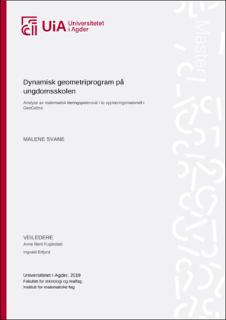| dc.description.abstract | In this study, I have analyzed two teaching packages in two textbooks designed for initial training in use of GeoGebra at Grade 8 in lower secondary school. I have explored the packages’ potential of learning for students, and I have also analyzed the mathematical content being processed, what components of GeoGebra are being worked on and how it is planned for students to work with it. My study is guided by one main research question and two additional sub-questions.How do the teaching packagesin the dynamic geometry softwareGeoGebrapresent challenges that have the potential to stimulate learning in mathematics for students in lower secondary school?1.What choices of tools and mathematical concepts are made inthe trainingpackages?2.How are the training packagesdesigned to present challenges to both strong and weak pupils in secondary school?The master thesis begins with an introduction where I present why I have chosen this topic and how dynamic geometry is integrated into the curricula in mathematics at the lower secondary school level. I present the research questions and some key concepts in this master's thesis, such as dynamic, construction and traditional tools.I presenttheory that offers explanations on what it means to learn mathematicsand I include some research on textbooks and computer software’s. I discuss learning theories, motivation, landscapesof discovery, inductive and deductive methods, black-box and white-box models and analysis of textbooks.I give a brief presentation about the historical development of dynamic geometry software’s, and especially GeoGebra. The two training packages selected for my empirical study is from the textbooksNumber 8 and Maximum 8.In the fourth chapter, the research design is presented and justified against research questions, and the approach to the data analysis of the training packages.Creating an analyticaltool has been an important part of this master's thesis. The analysis tool is divided in three parts with the main headings «design of the task», «dynamic geometrysoftware» and «learning potential». Then a large chapter is followed up where I use the analysis tool to analyze the two training packages. The package from Number 8 is analyzed first and Maximum 8 is analyzed afterwards. Afterwards I have a chapter where I have discussed and compared the two training materials. Then I endthe master thesis witha conclusion and some reflectionson the use of the analytical tool and the way forward.One of the things I have found is that the two teaching packagesare different and emphasize different things. They each have their own focus, both with regard to thetraining of the GeoGebra softwareand the mathematics presented. At the same time, there are some similarities between them, such that both manage to bring outthe dynamic with GeoGebra. Both also start with simple tasks in the beginning to get as many studentsas possible.I have found pros and cons of both teaching packages. At the same time, often what is different between them, such as the size difference, can be both an advantage and disadvantage at the same time, depending on how you look at it. | en_US |

